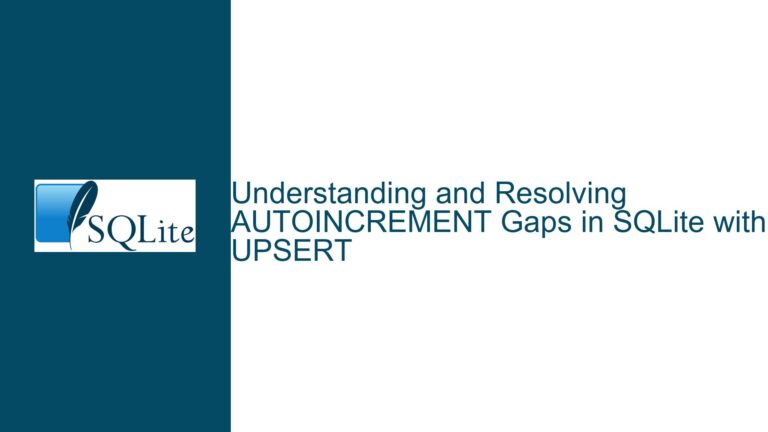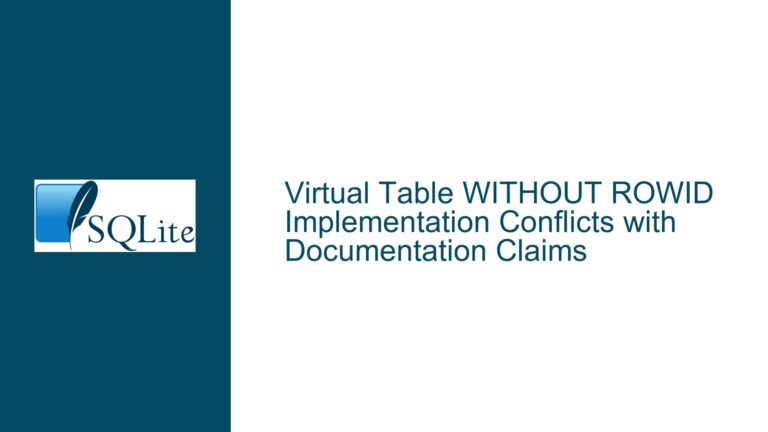Dropping RTREE Tables in SQLite: Issues and Solutions
Issue Overview: Dropping RTREE Tables and Associated Subtables
When working with SQLite’s RTREE virtual tables, users may encounter unexpected errors when attempting to drop the RTREE table or its associated subtables. The RTREE virtual table is a specialized index used for spatial data, and it relies on several underlying tables to function correctly. These subtables include block_index_rowid, block_index_node, and block_index_parent, which store metadata and structural information necessary for the RTREE index to operate efficiently.
The core issue arises when a user attempts to drop the RTREE table (block_index) after having already dropped one of its subtables (block_index_rowid). This action leads to a "SQL logic error" or a "Parse error: no such table" error, depending on the sequence of operations. The problem is rooted in the interdependency between the RTREE table and its subtables. SQLite expects these subtables to exist when the RTREE table is dropped, as they are integral to its internal structure. When a subtable is dropped first, the RTREE table is left in an inconsistent state, making it impossible to drop the RTREE table cleanly.
This issue highlights a gap in SQLite’s handling of RTREE table dependencies. While SQLite provides robust mechanisms for managing standard tables and indexes, the specialized nature of RTREE tables requires additional safeguards to prevent users from inadvertently breaking the table’s internal structure. The current behavior can lead to confusion, especially for users who are not familiar with the internal workings of RTREE tables.
Possible Causes: Understanding the RTREE Table Structure and Dependencies
To fully grasp the issue, it is essential to understand the structure and dependencies of RTREE tables in SQLite. An RTREE table is not a single table but rather a collection of interrelated tables that work together to provide spatial indexing capabilities. When an RTREE table is created, SQLite automatically generates several subtables to store the index’s metadata and hierarchical structure. These subtables include:
block_index_rowid: This table maps row IDs to node numbers, which are used to identify specific entries within the RTREE index.block_index_node: This table stores the actual data for each node in the RTREE index, including the spatial boundaries of each entry.block_index_parent: This table maintains the hierarchical relationships between nodes, allowing the RTREE index to efficiently query spatial data.
These subtables are tightly coupled with the RTREE table (block_index). When the RTREE table is dropped, SQLite expects to clean up these subtables as part of the drop operation. However, if a user drops one of the subtables manually before dropping the RTREE table, the RTREE table is left in an inconsistent state. SQLite’s internal mechanisms for managing RTREE tables do not account for the possibility of missing subtables, leading to errors when attempting to drop the RTREE table.
The root cause of the issue lies in SQLite’s assumption that the subtables will always exist when the RTREE table is dropped. This assumption is reasonable from a design perspective, as the subtables are integral to the RTREE table’s functionality. However, it does not account for user errors, such as manually dropping a subtable before dropping the RTREE table. This oversight can lead to a situation where the RTREE table cannot be dropped cleanly, leaving the database in an inconsistent state.
Troubleshooting Steps, Solutions & Fixes: Resolving RTREE Table Drop Errors
To address the issue of dropping RTREE tables and their associated subtables, users can follow several troubleshooting steps and solutions. These steps aim to either prevent the issue from occurring in the first place or resolve it if it has already occurred.
Preventing the Issue: Best Practices for Managing RTREE Tables
The best way to avoid issues with dropping RTREE tables is to follow best practices for managing these specialized tables. Users should always drop the RTREE table (block_index) first, allowing SQLite to handle the cleanup of the associated subtables automatically. This approach ensures that the RTREE table and its subtables are dropped in the correct order, preventing any inconsistencies.
Additionally, users should avoid manually dropping the subtables (block_index_rowid, block_index_node, and block_index_parent) unless they have a specific reason to do so. Manually dropping these subtables can lead to the issues described earlier, as SQLite expects them to exist when the RTREE table is dropped.
Resolving the Issue: Dropping RTREE Tables with Missing Subtables
If a user has already dropped one of the subtables and is unable to drop the RTREE table, there are several steps they can take to resolve the issue. These steps involve manually cleaning up the remaining subtables and ensuring that the RTREE table is dropped cleanly.
Identify the Missing Subtable: The first step is to identify which subtable has been dropped. In the example provided, the
block_index_rowidtable was dropped, leading to the error. Users can check the database schema to determine which subtables are missing.Recreate the Missing Subtable: If possible, users can recreate the missing subtable with the same structure as the original. This step may not always be feasible, as the subtable may contain data that cannot be easily reconstructed. However, if the subtable is empty or can be recreated without data, this approach may allow the RTREE table to be dropped cleanly.
Manually Drop the Remaining Subtables: If recreating the missing subtable is not an option, users can manually drop the remaining subtables (
block_index_nodeandblock_index_parent). This step should be done with caution, as it will leave the RTREE table in an inconsistent state. However, it may allow the RTREE table to be dropped without errors.Drop the RTREE Table: After manually dropping the remaining subtables, users can attempt to drop the RTREE table (
block_index) again. If the subtables have been dropped correctly, SQLite should allow the RTREE table to be dropped without errors.Clean Up the Database: Once the RTREE table and its subtables have been dropped, users should clean up the database to ensure that no remnants of the RTREE index remain. This step may involve checking for any orphaned data or metadata related to the RTREE table and removing it manually.
Long-Term Solutions: Enhancing SQLite’s Handling of RTREE Tables
While the above steps can help resolve the issue in the short term, a more robust solution would involve enhancing SQLite’s handling of RTREE tables to prevent these issues from occurring in the first place. Potential enhancements include:
Dependency Checking: SQLite could implement dependency checking when dropping subtables associated with an RTREE table. If a user attempts to drop a subtable, SQLite could check whether the subtable is associated with an RTREE table and prevent the drop operation if it is. This approach would prevent users from inadvertently breaking the RTREE table’s internal structure.
Graceful Handling of Missing Subtables: SQLite could enhance its handling of RTREE tables to gracefully handle missing subtables. If a subtable is missing when the RTREE table is dropped, SQLite could proceed with the drop operation and clean up any remaining subtables. This approach would make the system more resilient to user errors.
Improved Documentation: SQLite could improve its documentation to provide clearer guidance on managing RTREE tables and their associated subtables. This documentation could include best practices for dropping RTREE tables and warnings about the potential consequences of manually dropping subtables.
By implementing these enhancements, SQLite could provide a more user-friendly experience for managing RTREE tables, reducing the likelihood of errors and making it easier for users to work with spatial data.
Conclusion
Dropping RTREE tables in SQLite can be a complex task, especially when dealing with the associated subtables. The interdependency between the RTREE table and its subtables means that users must take care to drop these tables in the correct order. Failure to do so can lead to errors and leave the database in an inconsistent state.
By following best practices for managing RTREE tables, users can avoid these issues and ensure that their databases remain clean and consistent. If issues do arise, the troubleshooting steps outlined above can help resolve them and restore the database to a working state.
In the long term, enhancements to SQLite’s handling of RTREE tables could provide a more robust solution, making it easier for users to work with spatial data and reducing the likelihood of errors. Until then, users should exercise caution when dropping RTREE tables and their associated subtables, ensuring that they follow the correct procedures to avoid issues.






